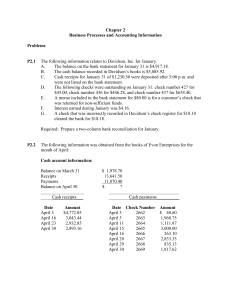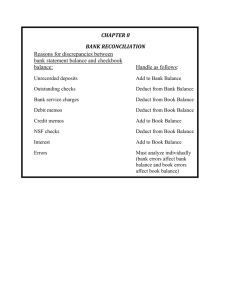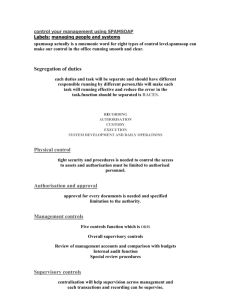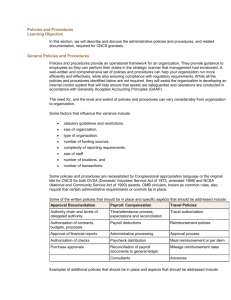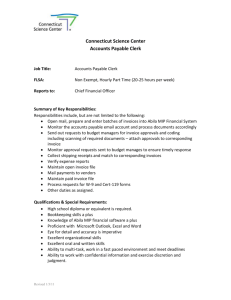ExerCh7
advertisement
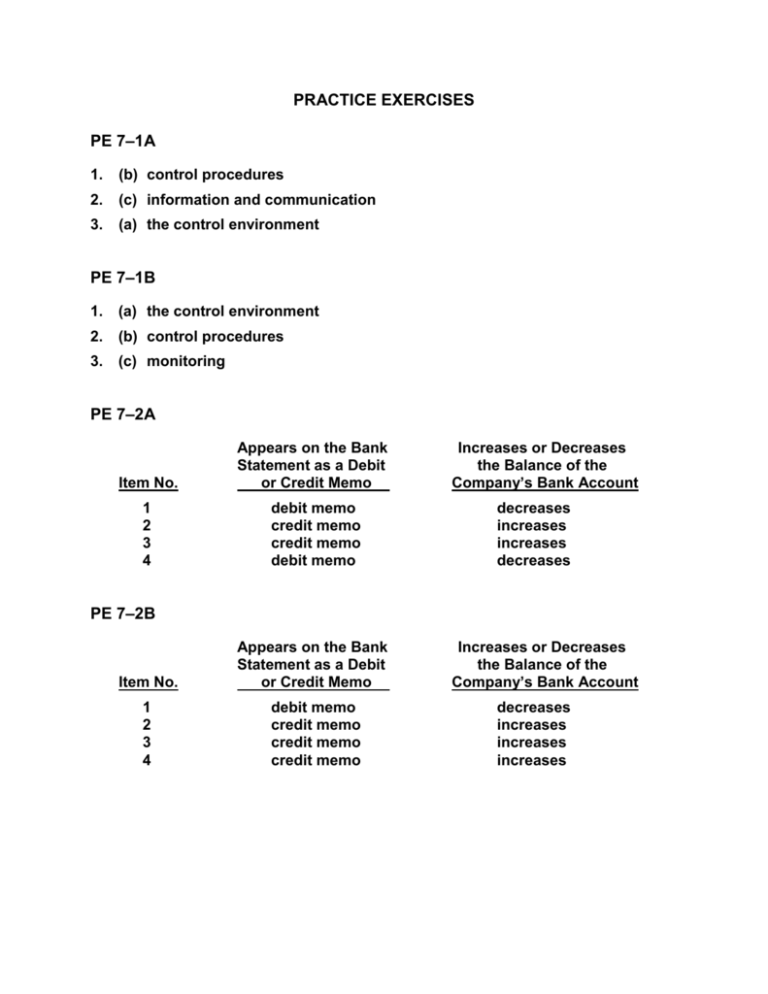
PRACTICE EXERCISES PE 7–1A 1. (b) control procedures 2. (c) information and communication 3. (a) the control environment PE 7–1B 1. (a) the control environment 2. (b) control procedures 3. (c) monitoring PE 7–2A Item No. Appears on the Bank Statement as a Debit or Credit Memo 1 2 3 4 debit memo credit memo credit memo debit memo Increases or Decreases the Balance of the Company’s Bank Account decreases increases increases decreases PE 7–2B Item No. Appears on the Bank Statement as a Debit or Credit Memo 1 2 3 4 debit memo credit memo credit memo credit memo Increases or Decreases the Balance of the Company’s Bank Account decreases increases increases increases PE 7–3A a. $24,000 as shown below. Bank section of reconciliation: $25,500 + $7,500 – $9,000 = $24,000 Company section of reconciliation: $27,475 – $75 – $3,400 = $24,000 b. Accounts Receivable .......................................... Miscellaneous Expense ...................................... Cash ................................................................ 3,400 75 3,475 PE 7–3B a. $15,000 as shown below. Bank section of reconciliation: $17,400 + $3,000 – $5,400 = $15,000 Company section of reconciliation: $5,765 + $9,360 – $125 = $15,000 b. Miscellaneous Expense ...................................... Cash ................................................................ 125 Cash...................................................................... Notes Receivable ........................................... Interest Revenue ............................................ 9,360 125 9,000 360 PE 7–4A a. Petty Cash ............................................................ Cash ................................................................ 800 b. Repairs Expense.................................................. Miscellaneous Selling Expense.......................... Cash Short and Over ........................................... Cash ................................................................ 450 75 50 800 575 PE 7–4B a. Petty Cash ............................................................ Cash ................................................................ 750 b. Store Supplies ..................................................... Miscellaneous Selling Expense.......................... Cash Short and Over ........................................... Cash ................................................................ 300 100 25 750 425 PE 7–5A a. Monthly Cash Expenses = = Ratio of Cash to = Monthly Cash Expenses = Negative Cash Flow from Operations 12 $72,000 = $6,000 per month 12 Cash as of Year - End Monthly Cash Expenses $58,800 = 9.8 months $6,000 per month b. The preceding computations indicate that Hauser Company has 9.8 months of cash remaining as of December 31, 2012. Hauser Company will need to generate positive cash flow from operations or raise additional financing from its owners or by issuing debt. PE 7–5B a. Monthly Cash Expenses = = Negative Cash Flow from Operations 12 $158,400 = $13,200 per month 12 Ratio of Cash to Cash as of Year - End = Monthly Cash Expenses Monthly Cash Expenses = $184,800 = 14 months $13,200 per month b. The preceding computations indicate that Preston Company has 14 months of cash remaining as of December 31, 2012. Preston Company will need to generate positive cash flow from operations or raise additional financing from its owners or by issuing debt. EXERCISES Ex. 7–1 Section 404 requires management’s internal control report to: (1) state the responsibility of management for establishing and maintaining an adequate internal control structure and procedures for financial reporting; and (2) contain an assessment, as of the end of the issuer’s fiscal year, of the effectiveness of the internal control structure and procedures of the issuer for financial reporting. The complete AICPA summary of Section 404 of Sarbanes-Oxley is as follows: Section 404: Management Assessment of Internal Controls. Requires each annual report of an issuer to contain an “internal control report,” which shall: (1) state the responsibility of management for establishing and maintaining an adequate internal control structure and procedures for financial reporting; and (2) contain an assessment, as of the end of the issuer’s fiscal year, of the effectiveness of the internal control structure and procedures of the issuer for financial reporting. Each issuer’s auditor shall attest to, and report on, the assessment made by the management of the issuer. An attestation made under this section shall be in accordance with standards for attestation engagements issued or adopted by the Board. An attestation engagement shall not be the subject of a separate engagement. The language in the report of the Committee which accompanies the bill to explain the legislative intent states, “…the Committee does not intend that the auditor’s evaluation be the subject of a separate engagement or the basis for increased charges or fees.” Directs the SEC to require each issuer to disclose whether it has adopted a code of ethics for its senior financial officers and the contents of that code. Directs the SEC to revise its regulations concerning prompt disclosure on Form 8-K to require immediate disclosure “of any change in, or waiver of,” an issuer’s code of ethics. Ex. 7–2 a. Disagree. It is commendable that Joan has given the employee a specific responsibility and is holding that employee accountable for it. However, after the cashier has counted the cash, another employee (or perhaps Joan) should remove the cash register tape and compare the amount on the tape with the cash in the drawer. Also, Joan’s standard of no mistakes may encourage the cashiers to overcharge a few customers in order to cover any possible shortages in the cash drawer. b. Disagree. Stealing is a serious issue. An employee who can justify taking a box of tea bags can probably justify “borrowing” cash from the cash register. c. Agree. Joan has made one employee responsible for the cash drawer in accordance with the internal control principle of assignment of responsibility. In addition, Joan has segregated the operations (preparing the orders) from the accounting (taking orders and payments). Ex. 7–3 a. The sales clerks could steal money by writing phony refunds and pocketing the cash supposedly refunded to these fictitious customers. b. Meridian Clothing suffers from inadequate separation of responsibilities for related operations since the clerks issue refunds and restock all merchandise. In addition, there is a lack of proofs and security measures since the supervisors authorize returns two hours after they are issued. c. A store credit for any merchandise returned without a receipt would reduce the possibility of theft of cash. In this case, a clerk could only issue a phony store credit rather than taking money from the cash register. A store credit is not as tempting as cash. In addition, sales clerks could only use a few store credits to purchase merchandise for themselves without management getting suspicious. An advantage of issuing a store credit for returns without a receipt is that the possibility of stealing cash is reduced. The store will also lose less revenue if customers must choose other store merchandise instead of getting a cash refund. The overall level of returns/exchanges may be reduced, since customers will not return an acceptable gift simply because they need cash more than the gift. The policy will also reduce the “cash drain” during the weeks immediately following the holidays, allowing Meridian Clothing to keep more of its money earning interest or use that cash to purchase spring merchandise or pay creditors. Ex. 7–3 (Concluded) A disadvantage of issuing a store credit for returns without a receipt is that preholiday sales might drop as gift-givers realize that the return policy has tightened. After the holidays, customers wishing to return items for cash refunds may be frustrated when they learn the store policy has changed. The ill will may reduce future sales. It may take longer to explain the new policy and fill out the paperwork for a store credit, lengthening lines at the return counter after the holidays. Sales clerks will need to be trained to apply the new policy and write up a store credit. Sales clerks also will need to be trained to handle the redemption of the store credit on future merchandise purchases. d. The potential for abuse in the cash refund system could be eliminated if clerks were required to get a supervisor’s authorization for a refund before giving the customer the cash. The supervisor should only authorize the refund after seeing both the customer and the merchandise that is being returned. An alternative would be to use security measures that would detect a sales clerk attempting to ring up a refund and remove cash when a customer is not present at the sales desk. These security measures could include cameras or additional security personnel discreetly monitoring the sales desk. Finally, an employee on the following work shift could be assigned the responsibility to restock returned merchandise and reconcile the returns to a refund list for the department. Ex. 7–4 As an internal auditor, you would probably disagree with the change in policy. Evergreen Bank has some normal business risk associated with default on bank loans. One way to help minimize this is to carefully evaluate loan applications. Large loans present greater risk in the event of default than do smaller loans. Thus, it is reasonable to have more than one person involved in making the decision to grant a large loan. In addition, loans should be granted on their merits, not on the basis of favoritism or mere association with the bank president. Allowing the bank president to have sole authority to grant large loans can lead to the president granting loans to friends and business associates, without the required due diligence. This can result in a bank becoming exposed to very poor credit risks. Indeed, this scenario is one of the causes of the savings and loan failures of the past. Ex. 7–5 The Société Générale trading losses show how small lapses in internal control can have large consequences. When the losses became so large that they could no longer be hidden, it was too late. The loss could have been avoided with a number of internal controls. First, the separation of duties control was overcome by the trader’s intimate knowledge of the monitoring software. This knowledge of the monitoring system allowed the trader to effectively hide trades. The design of the monitoring software would need to be improved, and access prohibited by traders. If traders have access to the monitoring software, then the separation of duties control is violated. Second, the trader should be under managerial oversight. For example, trades that exceed a certain amount of exposure should require management approval. In this way, a trader would be forced to slow down or stop once trades have reached a certain limit. This would avoid the trader’s tendency to try to “make up” losses with even larger bets. Lastly, required vacation time may have alerted managers to the hidden losses once the trader was unable to attend to the trading positions. Ex. 7–6 This is an example of a fraud with significant collusion. Frauds that are perpetrated with multiple parties in different positions of control make detecting fraud more difficult. In this case, the fraud began with an employee responsible for authorizing claim payments. This is a sensitive position because his decisions would initiate payments. However, claims would need to be authorized and verified before payment would be made. Knowing this, the employee made sure each claim had a phony “victim.” Thus, there was a verifiable story behind each claim. Only by tracking physical evidence of the accident could it be discovered that the claim was fictitious. However, the very nature of the process was to resolve small claims quickly without excessive control. Lastly, corrupt lawyers were brought into the fraud to act as attorneys for the claimants. This gave the claims even more credibility. In actuality, the lawyers had done legitimate business with the trucking company, so all appeared normal. This fraud was discovered when the fraudulent employee’s bank noticed irregularities in his bank account and notified authorities. As the saying goes, “Follow the money!” As a side note, the corrupt claims administrator fell into this behavior due to gambling problems. Ex. 7–7 Frog Sound Co. should not have relied on the unusual nature of the vendors and delivery frequency to uncover this fraud. The purchase and payment cycle is one of the most critical business cycles to control, because the potential for abuse is so great. Purchases should be initiated by a requisition document. This document should be countersigned by a superior so that two people agree as to what is being purchased. The requisition should initiate a purchase order to a vendor for goods or services. The vendor responds to the purchase order by delivering the goods. The goods should be formally received using a receiving document. An accounts payable clerk matches the requisition, purchase order, and invoice before any payment is made. Such “triple matching” prevents unauthorized requests and payments. In this case, the requests were unauthorized, suggesting that the employee has sole authority to make a request. Second, this employee had access to the invoices. This access allowed the employee to change critical characteristics of the invoice to hide the true nature of the goods being received. The invoice should have been delivered directly to the accounts payable clerk to avoid corrupting the document. There apparently was no receiving document (common for smaller companies); thus, only the invoice provided proof of what was received and needed to be paid. If there had been a receiving report, the invoice could not have been doctored and gone undetected, because it would not have matched the receiving report. Note to Instructors: This exercise is based on an actual fraud. Ex. 7–8 a. The most difficult frauds to detect are those that involve the senior management of a company that is in a conspiracy to commit the fraud. The senior managers have the power to access many parts of the accounting system, while the normal separation of duties is subverted by involving many people in the fraud. In addition, the authorization control is subverted because most of the authorization power resides in the senior management. b. Overall, this type of fraud can be stopped if there is a strong oversight of senior management, such as an audit committee of the board of directors. Individual “whistle blowers” in the company can make their concerns known to the independent or internal auditors who, in turn, can inform the audit committee. The audit committee should be independent of management and have the power to monitor the actions of management. Ex. 7–9 a. The sales clerks should not have access to the cash register tapes. b. The cash register tapes should be locked in the cash register and the key retained by the cashier. An employee of the cashier’s office should remove the cash register tape, record the total on the memo form, and note discrepancies. Ex. 7–10 Bison Burgers suffers from a failure to separate responsibilities for related operations. Bison Burgers could stop this theft by limiting the drive-through clerk to taking customer orders, entering them on the cash register, accepting the customers’ payments, returning customers’ change, and handing customers their orders that another employee has assembled. By making another employee responsible for assembling orders, the drive-through clerk must enter the orders on the cash register. This will produce a printed receipt or an entry on a computer screen at the food bin area, specifying the items that must be assembled to fill each order. Once the drive-through clerk has entered the sale on the cash register, the clerk cannot steal the customer’s payment because the clerk’s cash drawer will not balance at the end of the shift. This change also makes the drive-through more efficient and could reduce the time it takes to service a drive-through customer. If another employee cannot be added, the weakness in internal control could be improved with more thorough supervision. The restaurant manager should be directed to keep a watchful eye on the drive-through area in order to detect when a clerk takes an order without ringing up the sale. Another option is for Bison Burgers to implement a policy that any customer who does not receive a receipt is entitled to a free bison burger, and advertise this policy at the cash register and drive-in window. This approach uses the customer as an internal control. Ex. 7–11 a. The remittance advices should not be sent to the cashier. b. The remittance advices should be sent directly to the Accounting Department by the mailroom. Ex. 7–12 Cash...................................................................... Cash Short and Over ........................................... Sales ................................................................ 27,943 57 28,000 Ex. 7–13 Cash...................................................................... Sales ................................................................ Cash Short and Over ..................................... 13,590 13,540 50 Ex. 7–14 The use of the voucher system is appropriate, the essentials of which are outlined below. (Although invoices could be used instead of vouchers, the latter more satisfactorily provide for account distribution, signatures, and other significant data.) 1. Each voucher should be approved for payment by a designated official only after completion of the following verifications: (a) that prices, quantities, terms, etc., on the invoice are in accordance with the provisions of the purchase order, (b) that all quantities billed have been received in good condition, as indicated on a receiving report, and (c) that all arithmetic details are correct. 2. The file for unpaid vouchers should be composed of 31 compartments, one for each day of the month. Each voucher should be filed in the compartment representing the last day of the discount period or the due date if the invoice is not subject to a cash discount. 3. Each day, the vouchers should be removed from the appropriate section of the file and checks issued by the disbursing official. If the bank balance is insufficient to pay all of the vouchers, those that remain unpaid should be refiled according to the date when payment should next be considered. 4. At the time of payment, all vouchers and supporting documents should be stamped or perforated “Paid” to prevent their resubmission for payment. They should then be filed in numerical sequence for future reference. The implementation and use of a computerized system would also reduce the chance that any available cash discounts are missed. For example, when invoices are received and approved for payment, they would automatically be scheduled for payment within the discount period. However, even in a computerized system, the use of an approval process that requires supporting docu-ments and indicating “paid” on these supporting documents is an important control for avoiding duplicate payments. Ex. 7–15 To prevent the fraud scheme described, Digit Tech must separate responsibilities for related operations. As in the past, all service requisitions should be submitted to the Purchasing Department. After receiving the service request, Purchasing should complete a Service Verification form, stating what service has been ordered and the name of the company that will provide the service. This form should be delivered via intercompany mail to the person responsible for verifying that the service was performed. This person should be someone who has firsthand knowledge of whether the service has been performed. This person, who must be someone other than the manager requesting the service, should fill in the date and time the service was received and sign the form. In addition, the vendor providing the service should sign the form before leaving the premises. When completed, the Service Verification form should be forwarded to the Accounting Department. Accounting will authorize payment of the vendor’s invoice after the Service Verification form has been compared with the invoice. Ex. 7–16 a. b. c. d. Addition to the balance per bank: (4), (5) Deduction from the balance per bank: (6) Addition to the balance per company’s records: (3), (7) Deduction from the balance per company’s records: (1), (2) Ex. 7–17 (1), (2), (3), (7) The preceding additions and deductions to the cash balance according to the company’s records require journal entries in the company’s records. Additions and deductions to the cash balance according to the bank’s records do not require the company to record journal entries. Ex. 7–18 a. MAPLEWOOD CO. Bank Reconciliation July 31, 20— Cash balance according to bank statement ........................... Add deposit in transit, not recorded by bank ........................ $16,230 2,950 $19,180 3,180 $16,000 Deduct outstanding checks ..................................................... Adjusted balance ...................................................................... Cash balance according to company’s records .................... Add error in recording check .................................................. $15,600 450 $16,050 50 $16,000 Deduct bank service charge .................................................... Adjusted balance ...................................................................... b. $16,000; the adjusted balance from the bank reconciliation should be reported on the July 31 balance sheet for Maplewood Co. c. Yes, the bank reconciliation must always balance (reconcile) to an adjusted balance. Ex. 7–19 Cash ............................................................................ Accounts Payable ................................................ 450 Miscellaneous Administrative Expense ................... Cash...................................................................... 50 450 50 Ex. 7–20 Cash ............................................................................ Notes Receivable ................................................. Interest Revenue.................................................. 21,200 20,000 1,200 Ex. 7–21 a. MUSKEGON CO. Bank Reconciliation May 31, 2012 Cash balance according to bank statement ................... Add: Deposit in transit on May 31 ................................... $11,300 5,200 $16,500 2,500 $14,000 Deduct: Outstanding checks ........................................... Adjusted balance .............................................................. Cash balance according to company’s records ............ Add: Error in recording Check No. 2219 as $810 instead of $180 ..................................................... Note for $8,000 collected by bank, including interest.................................................................. Deduct: Bank service charges ........................................ Adjusted balance .............................................................. $ 5,110 $ 630 8,320 8,950 $14,060 60 $14,000 b. $14,000 Ex. 7–22 1. The heading should be “November 30, 2012,” and not “For the Month Ended November 30, 2012.” 2. The outstanding checks should be deducted from the balance per bank. 3. The deposit of November 30, not recorded by the bank, should be added to the balance per bank. 4. Service charges should be deducted from the balance per company’s records. 5. The error in recording the November 23 deposit of $6,100 as $1,600 should be added to the balance per company’s records. Ex. 7–22 (Concluded) A correct bank reconciliation would be as follows: ALMA CO. Bank Reconciliation November 30, 2012 Cash balance according to bank statement ............ Add deposit of November 30, not recorded by bank $12,090 4,000 $16,090 Deduct outstanding checks: No. 915 ............................................................... 960 ............................................................... 964 ............................................................... 965 ............................................................... Adjusted balance........................................................ Cash balance according to company’s records ................................................................ Add: Proceeds of note collected by bank: Principal ...................................................... Interest ........................................................ Error in recording November 23 deposit as $1,600 instead of $6,100 ............................ Deduct: Check returned because of insufficient funds.............................. Service charges .......................................... Adjusted balance........................................................ $ 850 615 850 775 3,090 $13,000 $ 4,430 $5,000 200 $5,200 4,500 $1,100 30 9,700 $14,130 1,130 $13,000 Ex. 7–23 a. The amount of cash receipts stolen by the sales clerk can be determined by attempting to reconcile the bank account. The bank reconciliation will not reconcile by the amount of cash receipts stolen. The amount stolen by the sales clerk is $5,500, determined as shown below. LASTING IMPRESSIONS CO. Bank Reconciliation April 30, 2012 Cash balance according to bank statement ................................... Deduct: Outstanding checks ........................................................... Adjusted balance .............................................................................. $20,500 6,800 $13,700 Cash balance according to company’s records ............................ Add: Note collected by bank, including interest............................ $ 8,900 10,400 $19,300 100 $19,200 Deduct: Bank service charges ........................................................ Adjusted balance .............................................................................. Amount stolen: $5,500 ($19,200 – $13,700) b. The theft of the cash receipts might have been prevented by having more than one person make the daily deposit. Collusion between two individuals would then have been necessary to steal cash receipts. In addition, two employees making the daily cash deposits would tend to discourage theft of the cash receipts from the employees on the way to the bank. Daily reconciliation of the amount of cash receipts, comparing the cash register tapes to a receipt from the bank as to the amount deposited (a duplicate deposit ticket), would also discourage theft of the cash receipts. In this latter case, if the reconciliation were prepared by an employee independent of the cash function, any theft of cash receipts from the daily deposit would be discovered immediately. That is, the daily deposit would not reconcile against the daily cash receipts. Ex. 7–24 a. Petty Cash ............................................................ Cash ................................................................ 1,200 b. Office Supplies .................................................... Miscellaneous Selling Expense.......................... Miscellaneous Administrative Expense ............ Cash Short and Over ........................................... Cash ................................................................ 650 230 90 30 1,200 1,000 Ex. 7–25 Toy manufacturers and retailers experience a seasonal trend in cash flows from operating activities. Mattel, Inc., experiences negative cash flows during the periods when merchandise is ordered for the holiday season. Mattel, Inc., generates positive cash flows during the holiday season, November–December. As a result, Mattel, Inc., reports overall positive net cash flows from operating activities for the year. Ex. 7–26 a. 9 months ($3,600,000/$400,000) b. At the current rate of operations, Pierport has 9 months of cash remaining. Pierport should either restructure its operations or begin planning on raising additional financing in order to continue in business. Ex. 7–27 a. $142.3 ($1,707/12) b. 29.9 months ($4,255/$142.3) c. Delta Air Lines reported a positive cash flow for the first and second quarters of 2009 and a small negative cash flow for the third quarter of 2009. In addition, Delta Air Lines has various financing agreements that allow it to access additional cash as necessary. Thus, it would appear that Delta Air Lines will continue to operate into the near future. Ex. 7–28 a. 2008: $3,570.8 ($42,850/12) per month 2007: $2,568.6 ($30,823/12) per month 2006: $2,095.6 ($25,147/12) per month b. 2008: 8.6 ($30,696/$3,570.8) months 2007: 6.3 ($16,103/$2,568.6) months 2006: 5.0 ($10,437/$2,095.6) months c. Since 2006, Allos Therapeutics monthly cash expenses have increased from $2,095.6 in 2006 to $3,570.8 in 2008. At the same time, the ratio of cash to monthly cash expenses has increased from 5.0 months at the end of 2006, to 8.6 months at the end of 2008. During 2007 and 2008, Allos Therapeutics sold additional stock, thus causing the increase in the ratio of cash to monthly cash expenses. However, Allos Therapeutics will run out of cash in less than nine months unless it changes its operations or raises additional financing. Unless the company improves its cash flows, it may have difficulty raising sufficient cash from investors or creditors to continue operations in the long term.
